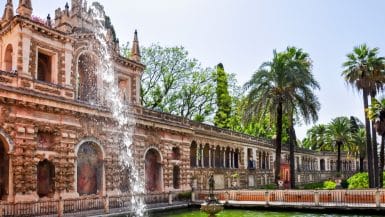The summer vacation this year falls flat? Then simply bring the Mediterranean flair into your home and transform your garden into a Mediterranean feel-good paradise. We have the best tips for you on how to upgrade your garden with simple tips and enjoy relaxing hours in the countryside.
Tip 1: Create an oasis of well-being with a cosy seating area
What is more reminiscent of a holiday than relaxing on a lounger by the pool? But even if you don’t have a pool to cool off in the garden, you can create a cosy place to relax. For example, create a beautiful sitting area with a garden table from Kees Smit, where you can enjoy a Mediterranean dinner together with your family. Comfortable and high-quality outdoor chairs ensure that you can spend many hours in the garden – and if you wish, you can even move your workplace outside.
A covered seating area is also suitable for the summer days. A pergola, overgrown with a real vine plant, provides pleasant shade and conjures up sweet grapes in autumn. Pavilions also fit perfectly into the Mediterranean style, providing shade and – depending on size and structure – even protection from moisture and cold.
Tip: Add the finishing touch to your cosy seating area with Mediterranean flair by adding colourful cushions and blankets in warm earth tones and playful patterns – this will create a welcoming atmosphere, invite you to linger and get you in the holiday mood in no time.
Tip 2: The best plants for southern flair
In addition to the culture and way of life of southern countries, flora and fauna are among the most important aspects of a Mediterranean lifestyle, which is why this is also reflected in the design of the gardens. Mediterranean plants are usually true sun worshippers and therefore need a lot of light and soil that is as permeable as possible and poor in nutrients. Unfortunately, many of the sun plants in our latitudes do not survive outdoors all year round, despite good care, which is why you can fall back on container plants in this case.
These ten plants should not be missing in a Mediterranean garden:
- Shrub roses: With their eye-catching flowers, roses underline the elegant charm of the southern garden and at the same time exude a delicious scent that directly reminds you of the Mediterranean.
- Cypress: The columnar growth transports you to Tuscany and provides a special Mediterranean flair.
- Citrus trees: Fruit trees look good in any garden – in the Mediterranean region, citrus trees such as lemon or orange are predominant. Due to the climate, however, these should only be cultivated as container plants and overwintered indoors.
- Daylilies: With their yellow-orange flowers, daylilies are a real ray of sunshine in the garden. The edible flowers are also considered a real insider tip in the kitchen.
- Oleander: The flowering shrub is one of the most popular ornamental plants in the south and is also popular as a container plant in this country. The eye-catching flowers make the pretty plant a real eye-catcher.
- Olive tree: Hardly any other plant is as typical of the Mediterranean region as the olive tree. Unfortunately, the beautiful tree is only hardy to a limited extent, which is why it shines in this country mainly as a container plant in the typical terracotta pot.
- Basil: What would a holiday on the Mediterranean be without fragrant herbs? Every friend of the Mediterranean lifestyle should plant basil in their garden – the aromatic and easy-care herb not only goes perfectly with pasta, but is also a hit for meat dishes and salads.
- Lavender: The intense scent and the unmistakable color immediately awaken the desire for a trip to Provence. In Germany , too, lavender blooms in the garden and even survives harsh winters without any problems.
Tip 3: Romantic garden lighting
To create an inviting and cosy holiday atmosphere in your garden, a sophisticated lighting concept with solar-powered fairy lights and lanterns is a good idea. So you can enjoy your green oasis many balmy summer evenings and take a break from everyday life. Outdoor fairy lights are particularly suitable, as they are weatherproof and can be stretched over terraces or garden plots to save space.
It is also creative to hang fairy lights or LED lights in flower pots or container plants to create soft lighting and a romantic mood. Solar lights placed in the ground provide subtle and indirect lighting along paths or steps. They make plants and decorative objects shine elegantly and skilfully set the scene for your garden at night. An additional advantage is that the use of solar-powered outdoor lights does not involve any electricity consumption and thus protects the environment.
Tip: You can conveniently illuminate your outdoor area at the desired times with the help of a motion detector or timer to create a coherent and well thought-out lighting concept.
Tip 4: Mediterranean color palette for garden decoration
When designing a Mediterranean garden, it is a good idea to use an appropriate colour palette as a guide for garden decoration. You can give your outdoor space an authentic Mediterranean flair by focusing mainly on warm earth tones such as terracotta, brown, yellow and ochre. These colors are reminiscent of the sun-drenched landscapes of the Mediterranean and fit perfectly with the Mediterranean aesthetic.
By using these shades in different elements of your garden decoration, such as plant pots, cushions, textiles or wall paints, you can achieve a uniform and appealing look. Vases or sculptures in appropriate colours also have an aesthetically pleasing effect. You will notice how these warm colors create a pleasant and relaxed mood in your garden and put you directly in the Mediterranean holiday mood.
Tip 5: General garden design
In the Mediterranean garden, not only the right plants are important, but also the arrangement of the beds and the choice of suitable materials play a major role. Typically, Mediterranean gardens are characterized by a symmetrical arrangement and clear geometric shapes. The central element is often water, which is accentuated by water features, fountains or ponds in the garden. Natural stones and weathered metal are particularly attractive materials – for the terrace and small paths in your Mediterranean garden, it is advisable to use natural stones or terracotta tiles or to cover the substrate with gravel.




